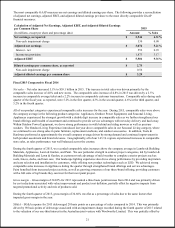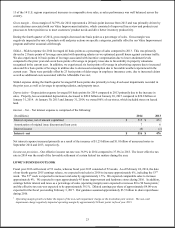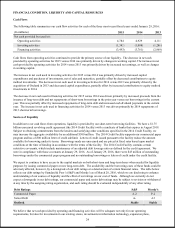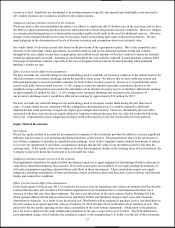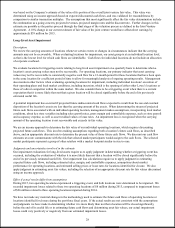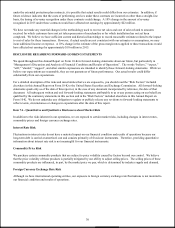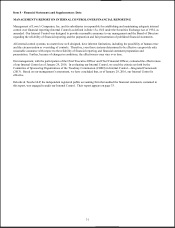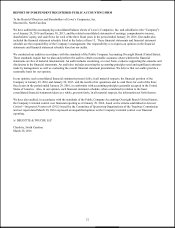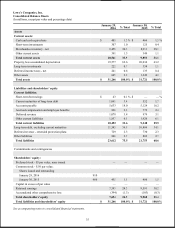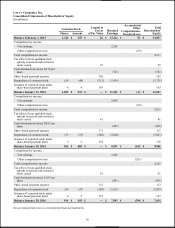Lowe's 2015 Annual Report Download - page 35
Download and view the complete annual report
Please find page 35 of the 2015 Lowe's annual report below. You can navigate through the pages in the report by either clicking on the pages listed below, or by using the keyword search tool below to find specific information within the annual report.
26
CONTRACTUAL OBLIGATIONS AND COMMERCIAL COMMITMENTS
The following table summarizes our significant contractual obligations at January 29, 2016:
Payments Due by Period
Contractual Obligations (in
millions)
Tota l
Less Than
1 Year
1-3
Ye a r s
4-5
Ye a r s
After 5 Years
Long-term debt (principal amounts, excluding
discount and debt issuance costs)
$
12,190
$
1,028
$
1,002
$
951
$
9,209
Long-term debt (interest payments)
8,236
522
946
905
5,863
Capitalized lease obligations 1, 2
991
76
127
118
670
Operating leases 1
5,394
494
959
855
3,086
Purchase obligations 3
1,046
718
173
111
44
Total contractual obligations
$
27,857
$
2,838
$
3,207
$
2,940
$
18,872
Amount of Commitment Expiration by Period
Commercial Commitments (in
millions)
Tota l
Less Than
1 Year
1-3
Ye a r s
4-5
Ye a r s
After 5 Years
Letters of Credit 4
$
67
$
66
$
1
$
—
$
—
1 Amounts do not include taxes, common area maintenance, insurance, or contingent rent because these amounts have historically been
insignificant.
2 Amounts include imputed interest and residual values.
3 Purchase obligations include agreements to purchase goods or services that are enforceable, are legally binding, and specify all significant
terms, including fixed or minimum quantities to be purchased; fixed, minimum or variable price provisions; and the approximate timing of
the transaction. Our purchase obligations include firm commitments related to certain marketing and information technology programs,
as well as purchases of merchandise inventory.
4 Letters of credit are issued primarily for insurance and construction contracts.
CRITICAL ACCOUNTING POLICIES AND ESTIMATES
The preparation of the consolidated financial statements and notes to consolidated financial statements presented in this Form
10-K requires us to make estimates that affect the reported amounts of assets, liabilities, sales and expenses, and related
disclosures of contingent assets and liabilities. We base these estimates on historical results and various other assumptions
believed to be reasonable, all of which form the basis for making estimates concerning the carrying values of assets and
liabilities that are not readily available from other sources. Actual results may differ from these estimates.
Our significant accounting policies are described in Note 1 to the consolidated financial statements. We believe that the
following accounting policies affect the most significant estimates and management judgments used in preparing the
consolidated financial statements.
Merchandise Inventory
Description
We record an obsolete inventory reserve for the anticipated loss associated with selling inventories below cost. This reserve is
based on our current knowledge with respect to inventory levels, sales trends and historical experience. During 2015, our
reserve decreased approximately $6 million to $46 million as of January 29, 2016.
We also record an inventory reserve for the estimated shrinkage between physical inventories. This reserve is based primarily
on actual shrinkage results from previous physical inventories. During 2015, the inventory shrinkage reserve increased
approximately $9 million to $171 million as of January 29, 2016.
In addition, we receive funds from vendors in the normal course of business, principally as a result of purchase volumes, sales,
early payments or promotions of vendors’ products. Generally, these vendor funds do not represent the reimbursement of
specific, incremental and identifiable costs that we incurred to sell the vendor’s product. Therefore, we treat these funds as a
reduction in the cost of inventory as the amounts are accrued, and recognize these funds as a reduction of cost of sales when the







